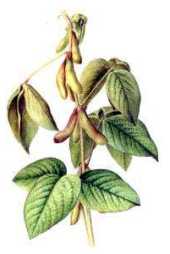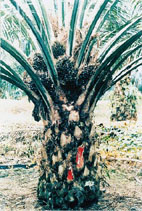
MAIN WORLD SOURCES
OF OILS
Around the world, it must be noticed that about 140 million tons of vegetal oils were produced in 2009/2010 and that about 70% of that production are accounted for four vegetal species:
1 – Soya oil, about 26% of the world production, in USA, Argentina, Brasil and China. The world production of soybean oil was 42.3 million tonnes in 2011-12.
Soybeans (Glycine soja) stem from China (mentioned at the time of the Emperor Chennung, 2800 B.C.). They were brought in Europe by missionaries (1740) and first grew in the Paris botanical garden. They were first taken to the United States as inexpensive ballast in 1804. A century later, G.W. Carver laid the foundation of new ideas about soybeans.

Today, soybean is the world’s leading source of oil as well as by-products and protein-rich seed meal. The highest domestic consumption is in Asia where soybean is a basic food since ancient times.
Besides the oil content of about 20%, the high protein content (about 35%) is of special importance as a protein source in the world. Crude soybean oil contains about 88% neutral lipids, 10% phospholipids and 2% glycolipids. Refining of soybean oil affords valuable by-products including lecithin during the degumming stage as the most available source of phospholipids and mixed tocopherols as a product of deodorisation.
The composition in triacylglycerol species is characterized by the presence of LLL (19%), OLL (15%), LLLn (10%), LOP (9%), OLO (6%), and OLLn (6%) (Holcapek M et al., J Chromatogr A 2003, 1010, 195). About 50% of soybeans come from the USA, 20% fro Brazil, 11% from Argentina, 9% from China, and 4% from India. More than 55 million hectares are used in the world for its cultivation.
Soybeans are the vegetable oilseed grown in largest amount : the world soybean production amounted to about 156 million tons in 1999-2000 and the yield is reported to be in the range 2300-4000 kg/ha. That production represents about 52% of total global oilseed production.
About 21% of soybean oil are produced in the United States, 17% in Brazil, 26% in China, 16% in Argentina, 5% in European Union, and 4% in India. The major usages of soybean oil are for food industry (77%), biofuels (17%), and oleochemicals (4%).
Recent world statistics on oilseed production in U.S. and in the world are found in the web site of the American Soybean Association
Refined soybean oil, before or after hydrogenation, is used in numerous edible products (more in North America than in Europe) : spreads, butter, margarine, frying and salad oils, mayonnaise, and as essential components of most baked goods. Soybean oil is also an important component of inks used for newsprint. Soybean’s many uses can be viewed on the web site of the American Soybean Association. Soybean oil has been proposed for the synthesis of polyurethane suitable for wide range of potential biomedical applications (Miao S et al., Eur J Lipid Sci Technol 2012, 114, 1165).
Pictures relating to soybean production, transportation and marketing may be found on the web site of the American Soybean Association.
Information on soybean may be found on the web sites SOJAXA and American Soybean Association.

This plant is the oil producer with the highest yield, one tree can produce up to 20 tonnes of fruit bunches per year. Each fruit consists of a hard kernel (seed) inside a soft shell (endocarp), which is surrounded by a fleshy mesocarp. The mesocarp contains about 49% palm oil and the kernel about 50% palm kernel oil. It has been reported that the commercial palm oil contains about 96% neutral lipids, 2.4% phospholipids and 1.4% glycolipids.
The triglyceride composition of palm oil is related to the formation of two main fractions, one is liquid, the other solid at ambient temperature. The composition in triacylglycerol species is characterized by the presence of LOP (24%), OOP (17%), LLP (8%), OLO (5%), and OOO (4%) (Holcapek M et al., J Chromatogr A 2003, 1010, 195). According to Voon PT et al., (Palm oil development, 2008, 48, 14) , palm olein TG contains only 7â11% palmitic acid at the sn-2 position, while 60â 70% of this position is occupied by oleic acid.
An exhaustive review on the chemistry and biochemistry of palm oil has been written by Sambanthamurthi R et al. (Prog Lipid Res 2000, 39, 507). The oil is mostly used as shortening, margarine and frying fat. It is also used in soap, candle manufacture and in the tin-plate industry. Its use as fuel in oil based biodiesel is increasing, mainly in Europe (about 500,000 tons in 2005).
About 37% of palm oil are produced from Malaysia where two thirds of the cultivated land are under oil palm. The average yield is about 4 ton/ha on a worldwide basis. The world production of palm oil was about 48 million tonnes in 2010/11. The highest production is in 2012 in South East Asia (49% in Indonesia, 37% in Malaysia , 3% in Thailand) and in Africa (2% in Nigeria, 1% in Cameroon and Côte d’Ivoire). Statistics of world supply and consumption may be found in a specialized web site.
High amounts of saturated fats in palm oil (high amount of palmitic acid) have been considered as less cardiovascular friendly than others. Generally, health care professionals consider palm oil as a hypercholesterolaemic fat. New data on the incidence of the sn-2 position of oleic acid seem to lead to new nutritional concepts for palm oil.
Several features and applications of palm oil have been reviewed (Norhaizan ME et al., Lipid technol 2013, 25, 39).
3 – Rape oil, about 12% of the world oil production, in EEC (26%), China (20.2%), India (11.3%), Canada (9.3%), and Japan (6.6%). 22.1 mt in 2009-10. In 2011, the major usages of rape oil are for food industry (67%), biofuels (27%) and oleochemicals (3%)
The origin of rape (Brassica napus, B. campestris) is not clear but its first mention is around 2000 B.C. in India. Analysis of archaeological materials has proved that Brassicaceae seed oil was used as illuminant in Nilotic shells from a first millennium AD Coptic church in Egypt (Romanus K et al., Anal Bioanal Chem 2008, 390, 783). Rape oil appears in Nederlands in 1360. As the plant withstands frost, it was cultivated in the moderate climates of the north or the far south.

In the mid-1930s it was grown almost entirely (90%) in China and India. Interest in this oilseed crop was developed during and after World War II. Until 15 years ago, rape oil was unsuitable for human nutrition because of its high content in erucic acid (up to about 50% of C22:1 n-9) which was shown to influence negatively the metabolism of several organs. The erucic acid-rich oil was used in Europe as a lamp oil, in the production of soaps and paints, and for cooking and in Canada as a lubricant. New varieties were developed with low erucic acid content (lower than 2%) and are known under the name Canola. Yields in the range 900-3000 kg/ha are reported. There is still a need for some high-erucic oil for industrial use (Lipid Technol 1994, 6, 79). Increasing quantities of rape oil are being used in Europe for biodiesel fuel, in the form of ethyl esters.
Seed breeders are trying to reduce the content of saturated fatty acids, to reduce the level of linolenic acid, to increase the level of oleic acid, lauric acid or g-linolenic acid. Rapeseed oil is also unusual in having substantial amounts of eicosenoic acid (C20:1 n-9). Its level has been reduced by plant breeding from about 10% to a level lower than 1%.
The average composition in triacylglycerol species is characterized by the presence of OLO (23%), OOO (17%), OLnO (11%), OLL (8%), OLLn (6%), OLnLn (4%) and LLLn (3%) (Holcapek M et al., J Chromatogr A 2003, 1010, 195).
The world production of rape seed was about 60.4 million tonnes and of oil was about 24.3 million tonnes in 2011/12. The EU-27 is the first producer of seeds (34%), then China (22%), Canada (21%), and India (11.6%). The major exporters of oil are Canada and Europe, the United States being the major importer. More than 33 million hectares are used in the world for rapeseed culture.
The use of that oil has changed rapidly during the 21rst century since the non-food use of rapeseed oil was only about 8% the production in 2000 while it amounted to about 33% in 2010.
General information and many links on Canola may be found on the web site of the Canola Council of Canada.
4 – Sunflower oil, about 13% of the world oil production, in EEC, Russia and Argentina. 15.3 million tonnes in 2011-12. In 2011, the major usages of sunflower oil is for food industry (96%).

An history of the plant and other details may be found on the Web Site of the National Sunflower Association.
To learn more on the fatty acid composition (weight percent) of these important oil products
Devenez membre et participez au développement de la Lipidomique au XXIème siècle.
S'inscrire